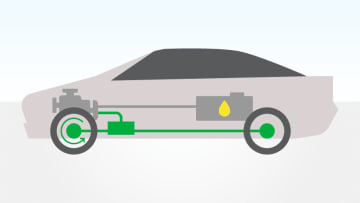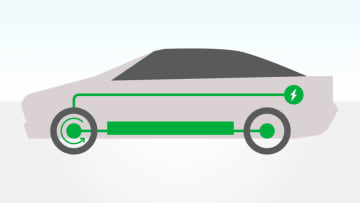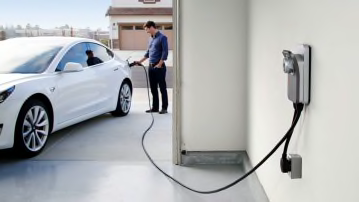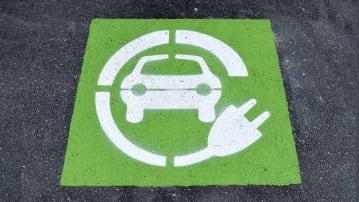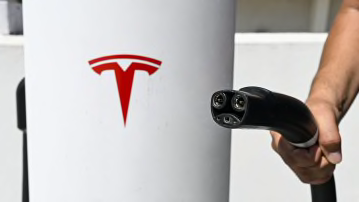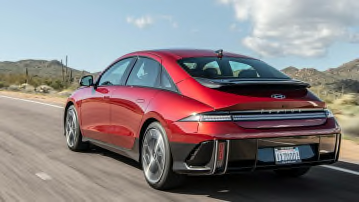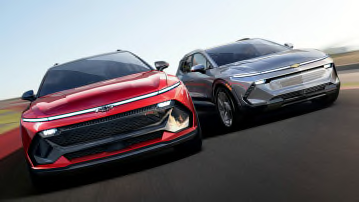Hybrids/EVs
Hybrids/EV Buying Guide
Find an Efficient Vehicle That’s Right for You
The experts at our Auto Test Center created this guide to help you choose a reliable and cost-effective hybrid, plug-in hybrid, or electric vehicle that fits your needs, with information about fuel economy, charging, and cost savings.
Photo: John Powers/Consumer Reports
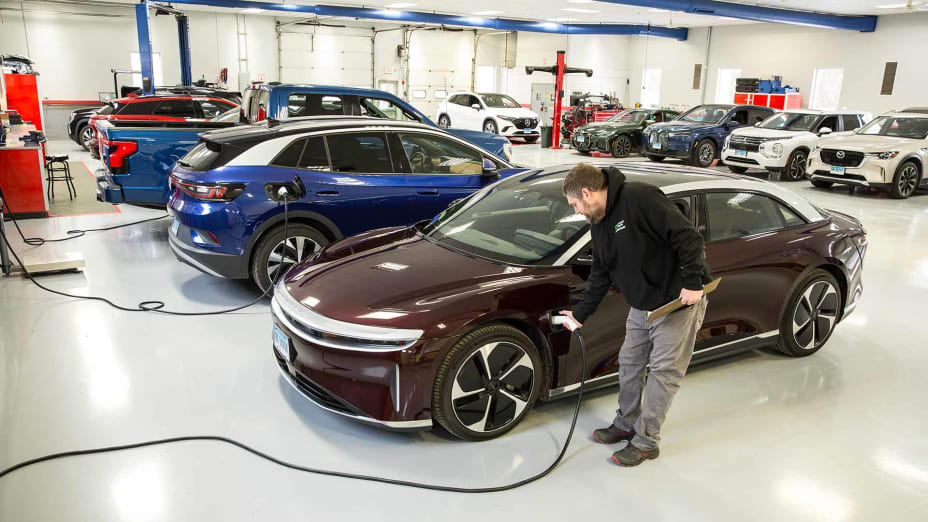
Top Hybrids/EVs Questions
What’s the difference between a hybrid, a PHEV, and an EV?
A hybrid blends a gas engine, a small battery, and an electric motor. It doesn’t need to be plugged in. A PHEV (plug-in hybrid electric vehicle) can be plugged in for 20 to 40 miles of electric-only range before the gas engine kicks in to extend the range for an additional 300 to 500 miles. An EV (electric vehicle) has a large battery and an electric motor, never uses gas, and has no tailpipe emissions.
-
Hybrid
Annual Fuel Cost $300-$800 less than a gas carPrice Premium $0-$3,000 more than an equivalent gas-only carRange 300-500 miles on gas, electric power at low speeds onlypros & consHybrid Ratings- Excellent gas mileage and lower emissions
- Don’t have to do anything differently from a gas-only car
- Can cost more than gas-only models
- Usually aren't eligible for any tax incentives
-
Plug-in Hybrid
Annual Fuel Cost Depends on how often you plug inPrice Premium $1,300-$14,000 more than an equivalent gas carRange 20-40 miles electric, 300-500 miles gaspros & consPlug-in Hybrid Ratings- No need to use chargers when away from home
- May be eligible for tax credits
- Higher purchase price
- Fuel savings only if you plug in often
-
Electric Vehicle
Annual Energy Cost About $1,300 less than gas carsPrice Premium $5,000-$15,000 more than a gas or hybrid carRange 200-400 miles between full chargespros & consElectric Vehicle Ratings- Instant and silent acceleration, little maintenance
- May be eligible for tax credits
- Higher purchase price, and may require home charger install
- Can require long charging stops on a trip
CR's experts explain how hybrid, PHEV, and electric powertrains work.
Will a hybrid, PHEV, or EV save me money?
See how gas and electricity costs will add up over five years based on vehicle type. Calculations for specific models can be found in our car comparison tool. Plus, check our incentive finder to see what savings you might be eligible for.
How does CR test and rate hybrids, PHEVs, and EVs?
We buy all the cars we test, putting them through their paces at our 327-acre Auto Test Center. For hybrids and PHEVs, we do fuel economy tests that reflect real-world driving, while EVs get even more unique evaluations.
-
Highway range testing
We want to know how long you can go between charges on a road trip, so we measure the range of every EV we test at highway speeds. We set the cruise control to 70 mph and record how many miles we can go until the battery is empty.
-
How fast it charges
On our vehicle model pages, we show how long it takes to charge the battery at a variety of chargers, from high-speed to slower and more common chargers. We score a car based on how quickly you add miles to its range and measure how long it takes to charge a PHEV with the included wall charger.
-
Ease of charging
Is the charging port easy to access? Can you quickly tell how much range is left and how long it will take to charge? Does the navigation system help you find nearby charging stations? These are just some of the questions we ask when evaluating an EV or a PHEV.
-
One-pedal driving
Many EVs and some PHEVs allow you to speed up or slow down by using only the accelerator pedal. We evaluate how easy it is to adjust this feature, and how smoothly drivers can slow down and stop.
What's with all this EV lingo?
Scratching your head over some of the acronyms and techy auto terms in this buying guide? Here's your crib sheet.
- kW
- Kilowatt, or one thousand watts. The unit for electrical power. For EVs, it is used to express the power output of an on-board charger or electric motor (which can be converted to horsepower).
- kWh
- Kilowatt hour. A unit of energy that is stored inside a battery. Think of it like a gallon of gasoline.
- MPGe
- Miles per gallon equivalent. Used to estimate the equivalent energy use of PHEVs and EVs to compare to cars without plugs. Importantly, not the same as a PHEV’s gas-only mpg.
- mi/kWh
- Miles per kilowatt hour. The EV version of MPG, this is miles traveled per unit of energy (kWh) in the battery. A higher number means greater efficiency. Typical numbers range between 2.0 and 4.0 mi/kWh.
- Gas-only mpg
- The gas mileage a PHEV gets when its battery is spent.
- Level 2 charger
- A 240-volt charger that can be installed at home or in public. Adds 20 to 30 miles of charge per hour, and can fully charge an EV’s battery overnight.
- DC fast charger
- A public charger that can add between 100 and 200 miles or more to an EV’s battery in 30 minutes. They usually cost money to use and are not as common as Level 2 chargers.
- Max acceptance rate
- The maximum power a vehicle can accept from a charger. EVs have two separate ratings for DC fast and Level 2 charging. PHEVs generally have only a Level 2 max acceptance rate.
- Regenerative brakes
- Capture momentum to create electricity as the car slows down or coasts. Used on hybrids, PHEVs, and EVs.
- One-pedal driving
- Using regenerative brakes, the driver can speed up or slow down just by modulating the accelerator pedal.
What do I need to know about charging?
If you’re buying an EV (or even a PHEV), you need to know about charging. Here are some of the essentials
-
What's the difference between chargers?
Illustration: Chris PhilpotEVs have one of three kinds of plugs. Tesla uses NACS (North American Charging Standard) for both Level 2 and DC fast charging. Many other automakers plan to use this kind of plug on newer vehicles. For DC fast charging, most non-Tesla EVs made before 2025 have an SAE/CCS combo plug. With a converter, CCS (Combined Charging Standard) can be used by Tesla models, and some Tesla chargers can be used by CCS cars. The Nissan Leaf uses CHAdeMO, which isn’t used by any other new EV sold in the U.S. and is not compatible with other plugs.
-
How can I charge a PHEV?
Photo: Consumer ReportsBecause they have smaller batteries, PHEVs take less time to charge at a Level 2 outlet than a pure EV. Many PHEVs can also be charged overnight at regular household 120V outlets using a mobile charging cable that comes with the car. Most PHEVs cannot be charged at DC fast chargers.
-
How much does it cost to install a charger at home?
Photo: ChargePointYou’ll need a professional electrician to install a Level 2 charger. Expect to pay about $500 to $1,200 for the work, plus $500 to $700 for the wall-mounted charging unit. A wiring upgrade may be needed in older homes and could cost thousands more. There are federal, state, and local incentives that can significantly reduce the cost of installing a charger at home. Some automakers and power companies also offer discounts.
-
How do I charge when I am traveling long distances?
Photo: Ben Hasty/Getty ImagesMost EV charging takes place at home. If you’re taking a longer trip, however, you’ll benefit from one of the 32,000 public DC fast-charging stations across the country. Many of these are designed for Tesla vehicles. More DC fast chargers are being built, and most are available near major highways. PHEVs can just go to a gas station when on a trip.
-
Why do I need a charging app?
Photo Illustration: Getty Images, PlugShareBecause public charging stations aren’t as common (or as reliable) as gas stations, apps such as A Better Route Planner are necessary to help you find a working charger on your route and let you know how busy it is. Once you’re there, apps associated with the charging provider, such as Electrify America or EVGo, allow you to activate the charger and pay for the electricity you use.
-
Who can charge at a Tesla Supercharger?
Photo: Getty ImagesTesla owners have access to a network of Tesla Supercharger DC fast-charging stations, and we have found that they make topping up a Tesla seamless, convenient, and relatively quick. Owners of other EVs rely on a patchwork of chargers that aren’t always convenient to access and may not be in working order. Tesla has begun allowing other EVs to charge at some of its Superchargers and says it plans to open more.
Are hybrids, PHEVs, and EVs reliable?
Consumer Reports’ annual car reliability survey reveals how they hold up.
-
Hybrids are extremely reliable
According to our car reliability survey, hybrids have fewer problems than gas-only vehicles. Many hybrids are no-nonsense vehicles from brands that shine in our reliability surveys regardless of what type of car they’re making.
-
When it comes to PHEVs, it depends on the brand
Plug-in hybrids effectively combine two powertrains under one hood and tend to be less reliable than gas-only cars on average, but many of the least dependable PHEVs are from brands that struggle with reliability in general. By contrast, auto manufacturers that usually make reliable vehicles also tend to make trustworthy PHEVs.
-
Some EVs are more reliable than others
On average, electric vehicle owners continue to report far more problems with their vehicles than owners of gas-only cars or hybrids. The majority of issues with EVs represent growing pains from all-new vehicle designs loaded with all the latest technologies, some of which come from manufacturers that are new to building cars.
-
Our reliability survey data is extensive
Every year we ask our members about problems they’ve had with their vehicles in the previous 12 months. This year, we gathered data on over 330,000 vehicles, looking at 20 trouble areas, from nuisances—such as broken interior trim—to major issues, such as engine, transmission, EV battery, and EV charging problems. (Learn more about car reliability.)
Got more questions about electrified vehicles? We have more answers.
If you want to learn more about hybrids, PHEVs, and EVs, we have a wealth of information to share. Below, you can find answers to some of the most commonly asked questions about these vehicles.
-
Which EVs and PHEVs qualify for tax credits?
Photo: FordSome new and used EVs and PHEVs qualify for federal tax credits of up to $7,500. But how much you’ll save depends on whether you buy or lease, where a car was made, how much the car costs, and how much you earn. Our guide helps break down your savings.
-
Which EVs have the longest ranges?
Photo: HyundaiIf you’re planning on taking road trips or want to go long distances between charges, these are the vehicles that can get between 250 and more than 400 miles on a single charge.
-
How do temperatures affect an EV’s range?
Photo: Adobe StockThere are many reasons why EV ranges drop in cold conditions. In our winter testing, we found that cold weather saps about 25 percent of range when cruising at 70 mph compared with driving in the same conditions during mild weather in the mid-60s.
-
How reliable are EVs, PHEVs, and hybrids compared with gas vehicles?
Photo: TeslaHybrids are some of the most reliable vehicles on the market. But PHEVs and EVs lag behind gas cars. Our experts share why.
-
How much do EVs cost to maintain?
Illustration: The Tom AgencyEVs have fewer moving parts than gas-powered vehicles, so you’ll spend less on routine maintenance. But you’ll still have to pay attention to your tires, suspension, and other wear-and-tear items.
-
Which new EVs are coming soon?
Photo: ChevroletThere are more and more electric cars on the market every year. Some come from legacy automakers, others from new startups. We take a look at new models that will be available in the near future.
















